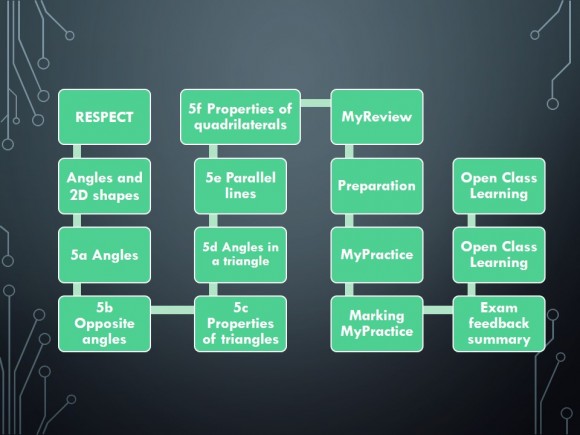Whatever happened to December? January for that matter? Sadly, I missed out a posting for our fourth unit, Angles and 2D Shapes. I also included an opportunity for “open class learning.” That is, using the feedback from the practice papers, an opportunity for students to direct their own learning. To questions or topics they identified they could improve. More on that later.
The unit required a fair amount of identification and recognition of angles and shapes, some where familiar some were not. Overall, the unit felt like we were building on existing knowledge, rather than introducing new knowledge. Angles, vertically opposite or angles on a straight line, posed few problems. Calculating angles in a triangle presented some challenge, not in terms of solving the problem, but calculating the answer. Parallel lines and perpendicular lines were as much a literacy challenge as much as a numeracy challenge. Identifying perpendicular lines at a ‘T’ easier to identifying than at an ‘E.’ Recognising parallelogram, trapezium and rhombus shapes will require frequent revision. The unit practice paper results were by far the best unit scores so far. They were also the most complete tests – the students are gradually becoming more determined.
The open learning sessions were an interesting learning experience for students and teaching experience for me. I concluded that learning independence and responsibility are skills and values students need to develop. I was explicit in my outline and there directed learning and peer teaching/learning. Elliot and JT, Hayley and Emily worked particularly well together, for periods of a lesson. It was not consistently effective or equally effective for all. That said, in my professional opinion, that the collective output was greater than it would have been if I had delivered “explicit instruction” of the units to the class. It would have been, and will be more effective as students learn to “take responsibility” for their learning.
What I learnt about introducing self-directed learning
- The use of the EFT made what to focus on very clear.
- Textbooks as revision tools were effective
- Small groups of 2 or 3 were more productive than 4
- There is value is students selecting their “teacher”, especially when that selection is based on the EFT results. It resulted in new working pairs. As a teacher, seeing new respectful partnerships develop was a real positive.
- Students completed the follow sentence on the board and in their books “I am learning today…” That simple commitment changed the climate in lesson two.
- Not all students were able to self-direct their own learning.
I will revisit self-directed learning. It worked effectively with evidenced areas for improvement offered by the EFT. Which gave purpose to revising and revisiting previous learning. I provided four lessons, nearly a weeks worth of lessons for two three terms work and they tell me they are ready to get back to taught lessons. What that inadvertedly told me was, taught lessons are perhaps preferable/easier/less work than self-directed learning?




